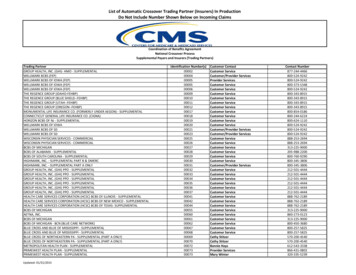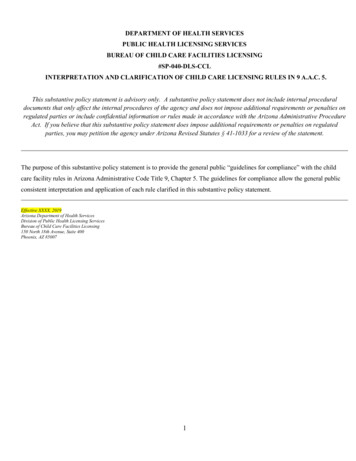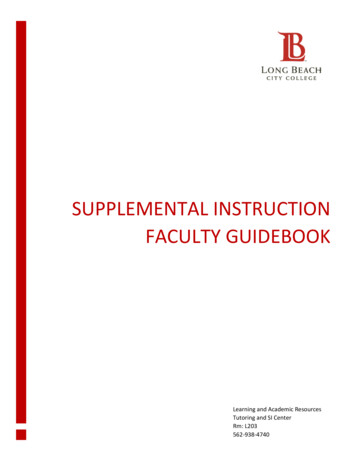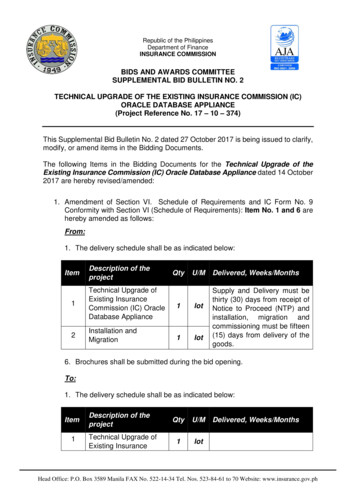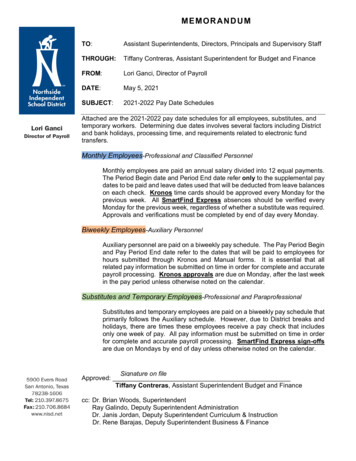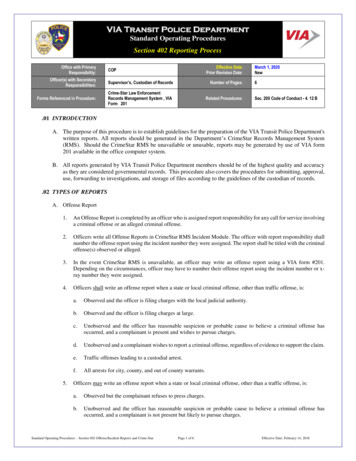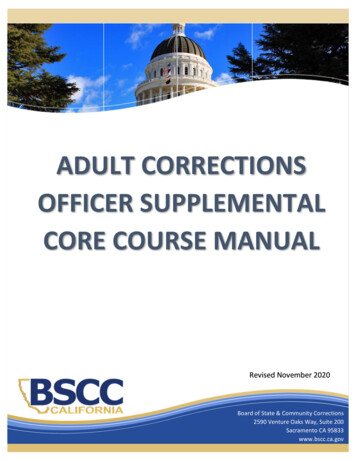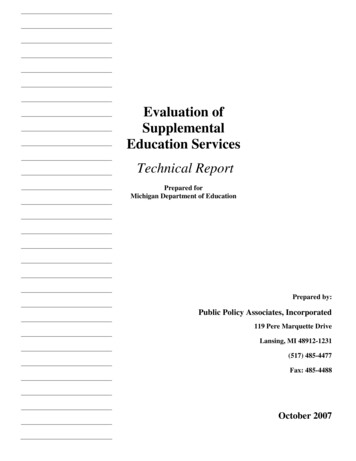
Transcription
Evaluation ofSupplementalEducation ServicesTechnical ReportPrepared forMichigan Department of EducationPrepared by:Public Policy Associates, Incorporated119 Pere Marquette DriveLansing, MI 48912-1231(517) 485-4477Fax: 485-4488October 2007
Table of ContentsIntroduction. 1Survey Process . 3CEPI Source Data . 3Parent Survey . 4Teacher Survey . 5District Coordinator Survey. 8Analysis of Impact of SES on Michigan Education Assessment Program Scores . 11Analysis Overview. 11Source Data. 11Identifying the Sample. 12Matched Control Group . 13Exploratory Analysis . 14Hierarchical Linear Modeling. 14Provider Coefficients . 16Provider Profiles . 19Recommendations for Change. 23Non-DPS District Coordinator Guidance Material.Appendix ADPS District Coordinator Guidance Material . Appendix B
AcknowledgmentsPublic Policy Associates, Inc. (PPA) would like to thank Michael Radke, LeahBreen, and Regina Allen of the Michigan Department of Education (MDE) Officeof School Improvement for their guidance and input in the design and execution ofthe evaluation as well as their interest in its products.Other members of the MDE also made critical contributions to the evaluation.Dave Judd extracted Michigan Education Assessment Program (MEAP) data tosupport an analysis of the impact of Supplemental Education Services (SES) onstudent achievement, and Joseph Martineau provided extensive and invaluablesupport in the use of hierarchical linear modeling methods as well as guidance onthe structure of Michigan Education Assessment Program scoring.We are also indebted to SES coordinators in districts throughout Michigan.District Coordinators provided PPA with timely guidance on the content of parent,teacher, and coordinator surveys used in the evaluation. They furthermoreoversaw the distribution of parent surveys and identified the most appropriateteachers to evaluate the effects of SES on every participating student in Michigan.The evaluation would not have been possible without their involvement.PPA team members contributing to this report include Ferzana Havewala, NancyHewat, Nancy McCrohan, Jennifer Perez-Brennan, Scott Southard, and consultantLisa Marckini-Polk. Any errors in the implementation of the evaluation orinterpretation of the data are the sole responsibility of PPA.
IntroductionThis report describes the methods used in the first of a planned series of annual evaluations ofSupplemental Education Services (SES) in Michigan. The evaluation was conducted by PublicPolicy Associates, Inc. (PPA), a national public policy research, evaluation, and programdevelopment firm located in Lansing, Michigan. Although work to develop the evaluationdesign began in 2006, most of the work of the evaluation was conducted in 2007.SES is provided to students throughout Michigan under the federal No Child Left Behind Act(NCLB). Under NCLB, it is the State’s responsibility to ensure that the providers that areapproved to offer SES meet certain quality standards. The evaluation represented a first steptoward creating an effective system for evaluating the performance of SES providers anddisseminating this information to parents and school districts throughout the state.The evaluation included four primary strands of activity: A survey of parents measured perceptions of the convenience of tutoring services, the qualityof communication from the SES provider, student improvement, and overall satisfaction withtutoring. A survey of teachers measured the nature and extent of communications between tutors andteachers and captured data on perceived student improvement and an overall assessment ofproviders. A survey of district-based SES coordinators measured the degree to which providers met theadministrative requirements of their contracts, perceptions of program quality, andperceptions of program fidelity. An analysis of Michigan Education Assessment Program (MEAP) scores estimated theimpact of SES on student achievement in math and English language arts/reading (ELA).The findings were reported through provider-specific profiles as well as a statewide summaryreport.This report was designed as an accompaniment to the statewide summary report and provides adetailed review of the data collection and analysis methods. The report is organized as follows: This section, the Introduction, provides an overview of the evaluation activities and context Survey Process describes the parent, teacher, and District Coordinator surveys and describesthe processes by which they were implemented. Analysis of Impact of SES on MEAP Scores reviews the data sources and methods used in astatistical exploration of the impact of SES delivered in 2005-2006 on participants’ 2006math and ELA MEAP scores. Provider Profiles describes the system by which providers were assigned performanceratings. Recommendations for Change identifies weaknesses in the evaluation approach and offerssuggestions for how they may be remedied in future evaluation of SES.Michigan Department of EducationTechnical Report: SES EvaluationPage 1October 2007Public Policy Associates, Incorporated
Appendix A includes guidance materials that were distributed to coordinators outside of Detroit,including instructions on conducting the parent, teacher, and District Coordinator surveys; andsome tracking instruments, primarily for the convenience of the coordinator in managing thesurvey process. The tracking instruments included pre-filled data specific to the district context(e.g., student names, provider names, etc.). The materials included in Appendix A are blanktemplates.Appendix B includes guidance material distributed to coordinators in the Detroit Public Schoolsystem.Michigan Department of EducationTechnical Report: SES EvaluationPage 2October 2007Public Policy Associates, Incorporated
Survey ProcessCEPI Source DataData on SES participants are captured in the Center for Educational Performance Information(CEPI) data collection. Beginning early in the evaluation and over the course of several months,PPA staff worked with state staff to define and obtain the data elements needed to implementparent and teacher surveys.There were a few lessons learned in this process. One issue that had not been immediatelyapparent was that the CEPI system was structured to gather SES information for 2006-2007 atthe end of the school year. This was at odds with the need to complete data collection for theevaluation before the end of the school year, when teachers and district staff would beinaccessible to PPA, and also at odds with the Michigan Department of Education’s (MDE’s)desired timeline for receiving evaluation results. In response to this, state staff workedaggressively to develop a process to collect some SES data early in 2007, and then re-open thesystem in the spring to collect data that would only be available after services had beendelivered.The CEPI data made available to PPA in March 2007 included student name, State of Michiganunique identification code (UIC), date of birth, gender, grade, district name and code, buildingname and code, and provider name. As districts must manually enter each student’s informationinto the CEPI database via an online data-entry system, it was unwieldy to have the DetroitPublic Schools (DPS) enter their cases, which numbered more than 11,000. Therefore, PPAreceived DPS SES data directly from the DPS technology office in February 2007.During the discovery process, it became apparent that there were some data elements that wouldbe extremely useful for the evaluation that did not exist in the CEPI system or were not readilyavailable in similar data systems. The evaluation design was updated to compensate for the lackof information on elements such as the subject of tutoring, the amount of service hours, andcontact information for parents or guardians. It had been intended that parents and teacherswould receive surveys targeted for math tutoring only and/or for ELA tutoring only; surveys hadto become more “universal.” 1 State staff worked with Michigan Department of InformationTechnology (DIT) staff to add variables capturing the subject area of tutoring and hours ofservice delivered to the Web-based data system for collection late in the school year.Although MDE’s work to advance data collection on student name and provider made theevaluation possible, the SES service-delivery system in the districts was both dynamic andongoing at the time districts were required to submit their student lists, resulting in a sample filewith significant inaccuracies. For example, the data systems did not necessarily reflect studentswho signed up but dropped out before services were delivered, students who changed providers,1In practice, as noted in the summary report on the SES evaluation, parents, teachers, and district coordinatorsrarely distinguished between providers’ math and ELA programs when evaluating quality and impact.Michigan Department of EducationTechnical Report: SES EvaluationPage 3October 2007Public Policy Associates, Incorporated
students who needed a new provider because the provider had dropped, and students who wereoffered SES very late in the school year. Districts varied widely in the timeline with which theyimplemented SES, and some with winter and spring service-startup goals were delayed ininitiating their programs due to contract problems and other administrative issues. For districtsthat implemented SES relatively late in the year, the data collected in winter was necessarilypreliminary and subject to change.The CEPI data file upon arrival had some issues such as missing data and duplicate cases. Thesewere minor issues and subsequent updated data files eventually appeared to reflect the intact andcomplete cases in the system. Additionally, in the course of processing surveys it has becomeapparent that certain providers’ names were variably entered into the data system, complicatingthe process of reporting provider-specific evaluation findings to MDE.Parent SurveyThe parent survey was a hardcopy survey delivered via postal mailing to the home addresses ofparents or guardians of students listed in CEPI (or DPS records) as participants in SES. Thesurvey was designed with the input and guidance of MDE staff, and PPA also consultedavailable materials developed by U.S. Department of Education contractors on best practices inSES evaluation. The survey instrument was printed on one double-sided piece of paper andcontained 24 questions, the last being open-ended. It was designed to be machine-readable(scannable) using Remark, a scanning software program, and was personalized using mail mergefields that supplied the students’ full name, UIC number (both in numerals and in barcode), andprovider name. Both the survey and its cover letter were written at the 6th grade reading level.The cover letter was on State of Michigan letterhead and included a footnote in Spanish directingSpanish-speaking parents to call PPA’s toll-free number to receive assistance in completing thesurvey.The subcontracted printing company packaged the survey, cover letter and a PPA pre-paidbusiness reply envelope in a sealed standard-sized envelope with a PPA return address. Theenvelope was labeled with both the UIC number and “To the Parent/Guardian of STUDENTNAME.”PPA arranged with the two largest districts, DPS and Flint, to mail the parent survey directlyfrom PPA. This process required these districts to provide files with parent contact informationto PPA and freed them from any physical handling of the mailing.For each of the other school districts in the state, PPA took the stuffed envelopes, grouped themin batches by building and alphabetically by student, and mailed them to District Coordinatorswith instructions for their distribution (District Coordinators also coordinated the teacher surveyprocess, as described later in this report). District Coordinators were to generate, match, andaffix mailing labels to these prepared envelopes. PPA also included extra self-addressedstamped envelopes in anticipation of some parents returning their surveys to the schools ratherthan using the reply envelope.Michigan Department of EducationTechnical Report: SES EvaluationPage 4October 2007Public Policy Associates, Incorporated
Technical assistance to District Coordinators for the parent survey was provided in the form of awritten instruction packet that described the materials in the mailing, their responsibilities in thesurvey process (in most cases, generating the mailing labels and dropping surveys in the mail),and special considerations if approached by parents for help. PPA had previously contacted eachDistrict Coordinator by e-mail or telephone to describe the survey process and their role within itand generally to set their expectations for the evaluation. Technical assistance was lent parentsduring the fielding of the survey via telephone; both a direct-dial and toll free number to PPAoffices was provided in the cover letter. A Spanish version of the survey was drafted for PPAstaff so that staff could conduct the parent survey via telephone as needed. All incoming phonecalls by parents were documented to track quantity, type, and the outcome of the issues theyraised. Seven incoming calls to PPA were from Spanish-speaking parents requesting assistancein completing the survey.District Coordinators were asked to mail parent surveys so that they would be in the field byMay 7, 2007 at the latest. Progress was then verified through contact on a weekly basis by PPAstaff (via fax, e-mail or telephone). In some cases (particularly in charter schools), DistrictCoordinators reported encouraging parents to fill out the survey.There were small challenges in fielding the survey from the point of view of executing themailing. The parent survey materials were shipped one day later from the other materialsalthough they were intended to be packaged together. In one district, an assistant dropped thesurveys in the mail without affixing the mailing label and these were returned to PPA by thepostal service. Also, as was to be expected, some addresses on district lists were not current, andthis resulted in undeliverable returned mail as well.While technical assistance was provided to parents this activity did not present any specificchallenge for execution. Most questions and comments pertained to the student’s status with agiven provider.Returned surveys were scanned using Remark software and analyzed in SPSS 14.0. The surveyearned a 9.9% response rate, or 7.7% when parents reporting their child did not receive SES areexcluded. The survey was pilot tested in Chadsey High School in the Detroit Public SchoolDistrict.Teacher SurveyThe teacher survey consisted of two separate online survey instruments, both implementedthrough SurveyMonkey, a Web service allowing users to design and implement their own onlinesurveys. The survey variants had identical questions but different data structures and invitationmethods. Both surveys were designed to collect one survey for every student enrolled in SES.The first survey instrument was dedicated exclusively to DPS, and requests to complete thesurvey were sent via e-mail to specific teachers for specific, named students. Teachers receivingthe e-mail were instructed to click the embedded link to evaluate the impact of SES delivered bythe provider named in the e-mail to the student named in the e-mail. A separate e-mail was sentMichigan Department of EducationTechnical Report: SES EvaluationPage 5October 2007Public Policy Associates, Incorporated
for each SES student, meaning that in many cases teachers received multiple requests tocomplete surveys. The e-mail-based survey invitation process was not originally intended foruse in the evaluation, but was developed at the request of DPS, and allowed PPA to trackresponse among specific teachers for specific students and to issue reminders where appropriate.The “from” address associated with the e-mail was a PPA research assistant e-mail address(ensuring that PPA would be aware of undeliverable addresses that “bounced back” to thesender), and the body of the e-mail alerted the reader that “The Michigan Department ofEducation is working in partnership with Public Policy Associates, Incorporated to evaluateSupplemental Education Services (SES) providers.”PPA worked with the DPS SES District Coordinator, Patricia Owens, to secure the assignmentand contact information necessary to deliver e-mail survey requests directly to appropriateteachers for each SES participant. PPA used the participant data previously submitted by DPS togenerate electronic student lists by building. These lists were compiled in a MS Excel documentand provided to the DPS District Coordinator, who distributed them to building coordinators.Building coordinators were then asked to identify (assign) the most appropriate teacher for eachSES student on the list, and to add that address information to the Excel document. Thecompleted lists were returned to the District Coordinator, who in turn sent them to PPA staff.This process was promoted during two informational meetings of SES Building Coordinators (ofwhich PPA attended one).The second online survey instrument was used to gather information for all other districtsproviding SES in the state (non-DPS), as well as those DPS buildings where coordinators couldnot develop an e-mail list on the necessary timeline. In these cases, PPA had no advanceknowledge of which teacher would complete the survey for a given student (nor was thisinformation captured during the survey process). The online survey instrument was thus genericacross all students and required the responding teacher to identify the student who was the focusof the survey by manually entering identifying information.In order to facilitate the proper identification of SES students as well as their assignment to anappropriate teacher for the purpose of the evaluation, PPA generated hardcopy survey-requestletters that described the purposes and timeline of the survey; identified the student throughmerge fields supplying the student’s name, grade, UIC number, and provider; and told teachershow to access the survey via a “tinyURL” address 2 or a longer SurveyMonkey uniform resourcelocator (URL). The letter was printed on state letterhead and was signed by the AssistantDirector of the Office of School Improvement.The survey-request letters were sent via postal service to District Coordinators at the same timeas other materials were distributed. District Coordinators were instructed to identify the mostappropriate teacher for each SES student and to distribute the request letters (one hardcopyinvitation per student) accordingly. As part of their guidance packet, coordinators were providedwith a list of district SES students in grid format with space to write the name of the assignedteacher. Given that the survey covered student improvement in both ELA and math and thatstudents in middle school and beyond would typically have different teachers for these classes,2tinyURL is a free online service where users submit a lengthy URL and are provided with a unique andsignificantly shorter URL that points to the same online location.Michigan Department of EducationTechnical Report: SES EvaluationPage 6October 2007Public Policy Associates, Incorporated
PPA also generated a random “E” or “M” for each student as an optional aid to the coordinator inselecting teachers in a balanced manner.There were known drawbacks to distributing hardcopy invitation letters, chief among them beingthat PPA did not know which teachers were ultimately assigned to respond with respect to anygiven student. Without this linking information, no targeted follow-up could be pursued, norcould a paper trail indicate whether the papers had been distributed by District Coordinators. Asthe survey was implemented, it was also observed that administrators did not always realize thatthe hardcopy invitations were personalized (the merged information figured at the bottom of theinvitation letter). As a result, in one district, just one invitation to each chosen teacher wasdistributed, with the remaining invitations discarded. In some other cases, teachers did likewiseupon receiving several invitations. PPA resent invitations where necessary.There were also significant pros and cons to the electronic distribution method devised for DPS.The chief advantage of the e-mail system was the ability to automate e-mail reminders and tolink a student with a particular assigned teacher, thereby allowing targeted follow-up. It also wasconvenient for teachers to reach PPA staff for technical assistance via e-mail inquiry. Finally,this freed the district staff from any role in follow-up contact with individual teachers andsimplified the distribution process from the coordinator perspective.However, the electronic method also engendered a variety of challenges and technical assistanceneeds. Building coordinators seemed to underestimate the amount of work it took to compilee-mail addresses and many did not turn the information in by the established deadline. Many ofthe contact lists returned to PPA were incomplete, leading PPA to calculate the percentcompletion rates for each building and determine whether response was sufficient to proceedwith e-mail invitations. The cut-off point was set at 80%. For those schools below the cut-offpoint (36 school buildings), hardcopy request letters were mailed instead.PPA tallied building-specific response rates from both the generic and targeted surveys on aweekly basis and communicated progress to District Coordinators. Among those buildings withvery low response rates using the e-mail approach, it was discovered that, in several cases, thebuilding coordinators had provided teacher e-mail addresses that were either universally inactiveor infrequently checked by teachers. Some teachers reported erasing all but the first e-mailinvitation they received, thinking the additional messages were duplicates. Typographical errorsin teacher e-mail addresses were also an issue. In other cases, teachers communicated to PPAthat they were unable or unwilling to respond to the survey for a variety of reasons: somecomplained via e-mail that they were assigned an unreasonable amount of students; wereincorrectly assigned students; had students whose truancy affected their ability to judge the effectof tutoring; had conflicts of interest due to a relationship with (or as) a provider; or had concernsabout how privacy laws would affect their sharing of student information (this list of concernswas not unique to the e-mail distribution system). PPA worked in collaboration with the DPSDistrict Coordinator to address these and other issues on an as-needed basis.The results from both surveys were merged and analyzed in SPSS 14.0. The survey earned a30.8% response rate; however, nearly 700 surveys were entirely composed of missing data andMichigan Department of EducationTechnical Report: SES EvaluationPage 7October 2007Public Policy Associates, Incorporated
had to be discarded. After these exclusions, the response rate was 22%. The e-mail survey waspilot-tested by teachers in Chadsey High School.District Coordinator SurveyThe District Coordinator survey was a survey administered in hard copy and consisted of tentopic areas printed on one double-sided piece of paper. The number of surveys given to eachDistrict Coordinator was equal to the number of providers in his or her district as reported bydistricts in CEPI. The hardcopy surveys were not personalized with the provider or districtname, but included spaces for capturing this information at the top of the page; a list of providersin each district was submitted along with the surveys for reference in personalizing them.The District Coordinator surveys were provided to District Coordinators via postal mailing in apackage containing District Coordinator survey instructions, teacher survey instructions andhardcopy invitations, a fax-back checklist form for coordinators’ administrative duties, andreturn envelopes. 3Technical assistance materials for this survey consisted of “District Coordinator SurveyInstructions,” which was provided with the surveys. The instructions listed materials, surveyresponsibilities, addressed special considerations, and referred questions to PPA staff. Thisdocument was supplemented with e-mail and telephone technical assistance on an as-neededbasis.The surveys were in the field starting in the last week of April 2007. On June 1st, a reminder email was sent to District Coordinators who had not returned surveys, requesting a reply as totheir status. On June 5, PPA sent electronic versions of the survey instrument to thosecoordinators who did not respond to the June 1st e-mail. This was followed with phone calls inthe second week of June.PPA anticipated that a challenge in the process might involve discrepancies between theproviders actually working with a district and those listed in the CEPI database. The technicalassistance document recommended that District Coordinators make photocopies of the survey inthe event that they needed to add additional active providers to the list provided by PPA. Duringthe fielding of the survey no coordinators sought technical assistance for this issue.One challenge which did arise, however, regarded the limited access by some DistrictCoordinators to providers’ contractual and operational information, which was central to thesurvey. In two cases, a District Coordinator was in fact a building coordinator of SES for acharter school whose provider records were kept off-site at the school’s charter schoolmanagement company. One individual sought to retrieve information from the management3Due to a vendor oversight, PPA was obliged to mail Parent Survey materials separate from this first mailing. Inmost cases this had no negative impact except where, for one district, the coordinator overlooked the first mailing(of District Coordinator and teacher survey materials) until follow up was made.Michigan Department of EducationTechnical Report: SES EvaluationPage 8October 2007Public Policy Associates, Incorporated
company, while another reported that he had consulted providers to verify information requestedin the District Coordinator survey.The District Coordinator surveys were manually entered into Microsoft Excel and analyzed inSPSS 15.0. The survey earned an 82.5% response rate.Michigan Department of EducationTechnical Report: SES EvaluationPage 9October 2007Public Policy Associates, Incorporated
Michigan Department of EducationTechnical Report: SES EvaluationPage 10October 2007Public Policy Associates, Incorporated
Analysis of Impact of SES on MichiganEducation Assessment Program ScoresAnalysis OverviewUnlike other elements of the 2007 SES Evaluation, analysis of the impact of SES on MichiganEducation Assessment Program (MEAP) scores focused on services delivered in the 2005-2006school year. Evaluation of the impact of SES on MEAP scores requires both a pre- and postservices MEAP score, and for students receiving SES in the 2006-2007 school year, nopost-services score will be available until fall 2007 MEAP tests have been taken and processed.The 2005-2006 school year was thus the most recent instance of SES delivery that could beevaluated.The analysis of the impact of SES on MEAP scores was restricted to students in grades 3 through7 in 2005. Students in other grades did not take MEAP tests in math and English languagearts/reading in both 2005 and 2006 and thus could not be included in the analysis.The analysis was conducted using a hierarchical linear modeling (HLM) approach relying on amatched group of students that did not participate in SES. HLM is the most appropriate form ofanalysis in many types of educational research as it accommodates “nested” data: that is, wherestudents are grouped into classrooms, school buildings, and districts and these settings areexpected to influence student outcomes. Additional information about HLM and the executionof the analysis f
The subcontracted printing company packaged the survey, cover letter and a PPA pre-paid . business reply envelope in a sealed standard-sized envelope with a PPA return address. The envelope was labeled with both the UIC number and "To the Parent/Guardian of STUDENT NAME." PPA arranged with the two largest districts, DPS and Flint, to mail .
